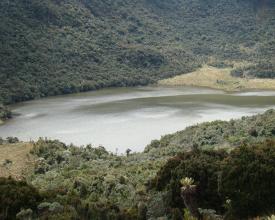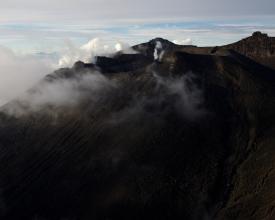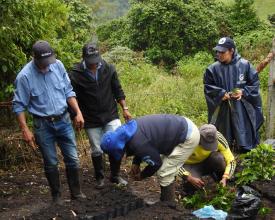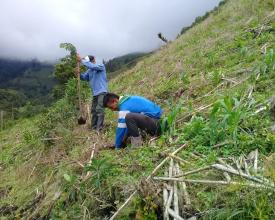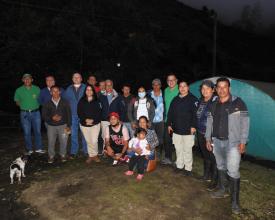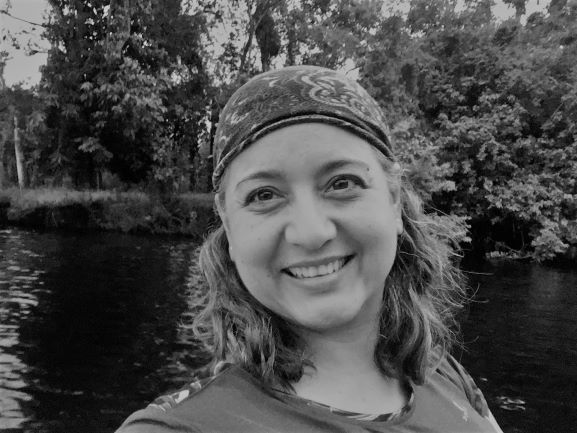
Conserving the Andean Forest of the Galeras Flora and Fauna Sanctuary: A Success Story of Participatory Ecological Restoration
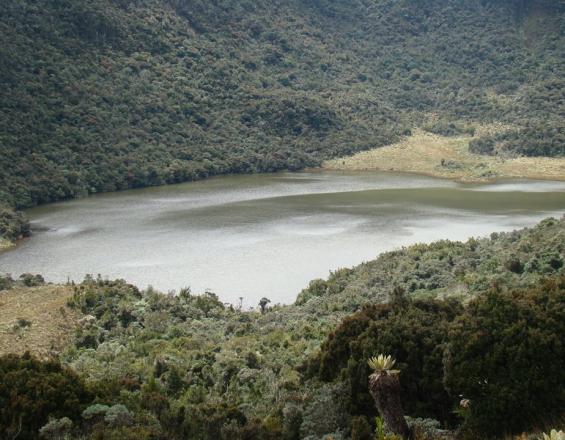
The protected areas administered by the National Natural Parks of Colombia (PNNC) present socio-environmental conflicts with the peasant communities, derived from the situation of use, occupation and tenure within the Protected Areas (PA). This aspect has been altering the state of conservation and its associated ecosystem services. In this sense, the Galeras Flora and Fauna Sanctuary (SFFG) has implemented since 2007 the Participatory Ecological Restoration strategy, which has reduced the pressures caused by cattle ranching and agriculture, while allowing the recovery and restoration of the PA's altered areas. Parallel to this process, in 2018 the SFFG initiated a process of environmental agreements between the PNNC and the farmers who use land within the PA, in order to fulfill its conservation mission and thus involve them in the mission processes.
Context
Challenges addressed
Social
- Management of pressures on the Andean ecosystems of the SFFG, in a context of land use and occupation within the Sanctuary.
- Recognition of permitted and non-permitted uses within the Sanctuary by the communities (land tenure).
- Promotion of community participation in the implementation of conservation practices.
Environmental
- Long-term consolidation of the restoration and recovery strategy for Andean ecosystems with the participation of strategic stakeholders.
- Reduction of the area occupied by intervened land cover due to conflicting land uses.
- Monitoring of the impact of ecological restoration processes.
Economic
- Generation of economic alternatives with a focus on sustainability for the communities, in accordance with the protection and conservation of Andean ecosystems.
- Management of human and financial resources to achieve PA conservation objectives.
Location
Process
Summary of the process
The Galeras Flora and Fauna Sanctuary -SFFG- has presented socio-environmental conflicts with the peasant communities due to non-permitted land uses, an aspect derived from the use, occupation and tenure situation. Considering this context, since 2007 the SFFG has been implementing the strategy of Participatory Ecological Restoration (REP), which has had the purpose of involving local communities throughout the restoration process. Therefore, in the first instance the methodology of observation and participatory research has been applied, which consists of making field trips with members of the community, to take geo-reference points with GPS, and then build the polygons to calculate the area to be restored. After this activity, a diagnosis of the conservation status of the area has been made, and the decision to implement passive or active restoration has been taken. Parallel to the ecological restoration actions, REP agreements have been formalized with the campesino communities in order to preserve the integrity of the protected area.
Building Blocks
Building block No. 1: Identification of the areas to be intervened through active and passive restoration actions.
The purpose of identifying the areas to be restored is to determine the number of hectares in which active restoration actions should be implemented (which consists of direct human intervention on the structure and characteristics of the degraded ecosystem, in order to replace, rehabilitate or restore it to ensure the existence of a structured and functional ecosystem) and passive restoration (focused on eliminating or minimizing the disturbances causing the degradation, leaving the degraded ecosystem to recover its structure and functionality by itself).This process was carried out through the methodology of observation and participatory research, which consists of making field trips with some members of the community, to take geo-reference points with the GPS, to subsequently build the polygons and calculate the area to be restored, which comprises 196.2 hectares. Parallel to this activity, a diagnosis of the conservation status and composition of the plant species present in the area is made to determine the degree of intervention to which the ecosystem has been subjected and thus make the decision on what type of restoration will be implemented.
Enabling factors
- Funding sources available from the National Government and international cooperation projects (GEF Mosaic Galeras Heritage Fund - KFW).
- Availability of geographic information systems.
- Willingness of rural communities to participate in restoration activities.
Lesson learned
- Building trust with the farming families, since they have been involved in the ecological restoration strategy activities, thus achieving a degree of co-responsibility in the conservation of the protected area.
- The SFFG technical team gained experience in carrying out active and passive restoration activities.
Social participation in the implementation of the ecological restoration strategy.
Its purpose is to involve local communities in the restoration process, depending on the socioeconomic environment prevailing in the area, with special attention to the aspirations of local communities in terms of the future they want for the space they inhabit. Therefore, in the implementation of the restoration strategy, local communities made up of children, youth and adults were involved in activities such as:
(i) Identification of the areas to be restored.
ii) Construction of community nurseries for the propagation of high Andean forest species. iii) Participation in the implementation of isolation in areas under pressure from agricultural activities, in order to encourage the use of the region's own natural resources that contribute to valuing the existing biodiversity and ensure the long-term continuity of the project, taking into account the important knowledge that the community has about their region, its history of use, the location of the species and in some cases their propagation.
Enabling factors
- Funding available from the National Government and international cooperation projects (GEF Mosaic Galeras Heritage Fund - KFW).
- Community ownership of the restoration work, guaranteeing the continuity of the process.
- Recognition of the communities regarding the existence of a protection figure.
- Knowledge of the communities and the work team of the territory and its ecosystems.
Lesson learned
- The ecological restoration strategy developed by the SFFG has involved the participation of the communities from the beginning, generating ownership in the conservation of the protected area's ecosystems.
- Scientific knowledge and ancestral knowledge of the communities should be considered in the ecological restoration processes.
- The strengthening of community nurseries has allowed the protected area to have adequate plant material for the implementation of ecological restoration actions, both in the interior and in the zone of influence. These nurseries also function not only as a source of plant production, but also as an experimental site for native species of interest, with the goal of creating temporary banks of germplasm and seedlings of native species that allow for their characterization, selection, and management. In the future, this will allow the design, knowledge and adaptation of the simplest techniques for the massive propagation of the different Andean species.
Implementation of Ecological Restoration Agreements
The agreements are aimed at preserving the integrity of the SFFG, through the release of transformed areas and the implementation of active and passive restoration processes, in order to achieve the recovery of degraded land cover and contribute to the maintenance of natural areas and the good living of the community.
To achieve the implementation of the ecological restoration agreements, it was necessary to carry out out outreach activities and socialization of the process with the 23 prioritized peasant families and also to collect information according to the guidelines of participatory ecological restoration, which allowed the construction of the technical annexes and the content of the agreements.
Enabling factors
- Funding sources available from the National Government and international cooperation projects (GEF Mosaic Galeras Heritage Fund - KFW).
- Willingness of key stakeholders to sign Ecological Restoration agreements.
Lesson learned
As a contribution to land management and the conservation objectives of the SFFG, the activities that have been developed within the framework of the agreements and the participatory process of ecological restoration, contribute to the appropriation of knowledge of the rural communities for the implementation of favorable practices for conservation, in a way that favors their quality of life and reduces socio-environmental conflicts. On the other hand, it is expected that in the short and medium term the communities will feel identified, involved and appropriate to the ecological restoration process and will be able to conceive a degree of social co-responsibility in the conservation of the protected area.
Impacts
- 196.2 hectares intervened and transformed inside the PA and in the buffer zone, which has contributed to stop the expansion of the agricultural frontier.
- Signing of 21 conservation agreements with 23 farming families to preserve the integrity of the SFFG, through the release of 45 hectares transformed through active and passive restoration processes.
- Generation of employment for the communities related to the PA.
- Environmental education through different actions that are necessary to carry out the ecological restoration processes (isolations, production and planting of native plant species, strengthening of community nurseries).
- Establishment of 2 community nurseries generating the construction of trust with the families related to the PA, both inside and in its zone of influence, allowing the valuation and recognition of the importance of the SFFG by the rural community.
- Recovery of vegetation cover to improve the supply of ecosystem services for the surrounding communities, such as water quantity and quality, CO2 fixation, associated biodiversity, soil recovery and protection, erosion control, among others.
Beneficiaries
Approximately 23 farming families settled in the Galeras Flora and Fauna Sanctuary.
Sustainable Development Goals
Story
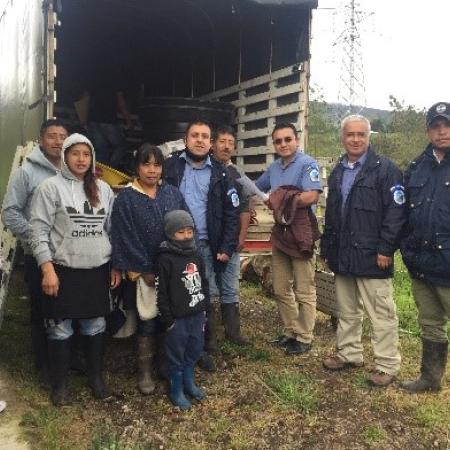
The Galeras Flora and Fauna Sanctuary -SFFG- was created in 1985, is located in the department of Nariño, in southern Colombia and has an area of 8229 hectares. Galeras has jurisdiction in 7 municipalities: Pasto, Nariño, La Florida, Sandoná, Consacá, Yacuanquer and Tangua. Its main ecosystems are: the sub-paramo, paramo, Andean forest and high Andean forest, which harbor a great biodiversity of great importance for the biological diversity of the department of Nariño.
To contribute to the management of this protected area, the SFFG, since 2007, has been implementing the strategy of Participatory Ecological Restoration, which has allowed the recovery and restoration of areas intervened by anthropogenic pressures, mainly related to livestock and agriculture.From 2010 to date, the SFFG has intervened in 196.2 hectares through passive ecological restoration actions (isolations) and active ecological restoration actions (enrichments), with the participation of the farming communities.
Parallel to this process, in 2018 the SFFG initiated an environmental agreement plan between the institution and the occupying farmers within the protected area, in order to comply with its conservation mission and thus involve them through the consultation processes within the mission strategies, which has led these families to perceive ecological, social and economic benefits through the improvement of sustainable production systems.
In this regard, in 2021, 21 conservation agreements have been signed with 23 farming families related to the protected area. These agreements were made in order to restore, conserve and increase ecological connectivity in the degraded areas of the Andean forest ecosystems of the protected area, freeing an area of approximately 45 hectares from pressures and at the same time generating ownership and co-responsibility in the conservation of the SFFG in the communities.
The implementation of the conservation agreements is being carried out with funding from the National Government and international cooperation projects (Global Environment Facility - GEF and the Galeras Mosaic Heritage Fund of the Development Bank - KFW).

